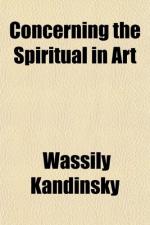It is not often that children draw religious scenes. More often battles and pageants attract them. But since the revival of the religious picture is so noticeable a factor in the new movement, since the Byzantines painted almost entirely religious subjects, and finally, since a book of such drawings by a child of twelve has recently been published, I prefer to take them as my example. Daphne Alien’s religious drawings have the graceful charm of childhood, but they are mere childish echoes of conventional prettiness. Her talent, when mature, will turn to the charming rather than to the vigorous. There could be no greater contrast between such drawing and that of—say—Cimabue. Cimabue’s Madonnas are not pretty women, but huge, solemn symbols. Their heads droop stiffly; their tenderness is universal. In Gauguin’s “Agony in the Garden” the figure of Christ is haggard with pain and grief. These artists have filled their pictures with a bitter experience which no child can possibly possess. I repeat, therefore, that the analogy between Post-Impressionism and child-art is a false analogy, and that for a trained man or woman to paint as a child paints is an impossibility. [Footnote: I am well aware that this statement is at variance with Kandinsky, who has contributed a long article—“Uber die Formfrage”—to Der Blaue Reiter, in which he argues the parallel between Post-Impressionism and child vision, as exemplified in the work of Henri Rousseau. Certainly Rousseau’s vision is childlike. He has had no artistic training and pretends to none. But I consider that his art suffers so greatly from his lack of training, that beyond a sentimental interest it has little to recommend it.]
All this does not presume to say that the “symbolist” school of art is necessarily nobler than the “naturalist.” I am making no comparison, only a distinction. When the difference in aim is fully realized, the Primitives can no longer be condemned as incompetent, nor the moderns as lunatics, for such a condemnation is made from a wrong point of view. Judgement must be passed, not on the failure to achieve “naturalism” but on the failure to express the inner meaning.
The brief historical survey attempted above ended with the names of Cezanne and Gauguin, and for the purposes of this Introduction, for the purpose, that is to say, of tracing the genealogy of the Cubists and of Kandinsky, these two names may be taken to represent the modern expression of the “symbolist” tradition.
The difference between them is subtle but goes very deep. For both the ultimate and internal significance of what they painted counted for more than the significance which is momentary and external. Cezanne saw in a tree, a heap of apples, a human face, a group of bathing men or women, something more abiding than either photography or impressionist painting could present. He painted the “treeness” of the tree, as a modern critic has admirably expressed it. But in everything he did he showed the architectural mind of the true Frenchman. His landscape studies were based on a profound sense of the structure of rocks and hills, and being structural, his art depends essentially on reality. Though he did not scruple, and rightly, to sacrifice accuracy of form to the inner need, the material of which his art was composed was drawn from the huge stores of actual nature.




